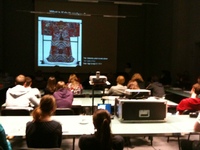- 日本文化研究班
2009年11月12日
KMKG Work shop-Mizuho Kamo
A Study of Kabuki Costume: Design Patterns Depicted in Ukiyo-e 【Abstract】
Kamo Mizuho, PhD Candidate, Ritsumeikan University
RA1の加茂です。
ベルギー王立美術歴史博物館ワークショップにて発表をしました。
歌舞伎衣裳の紹介や具体的な事例を提示して発表を行いました。

In this workshop, I present a case study of kabuki costumes by using “the ARC Ukiyo-e Database.” Focusing on actor prints, I analyze Omiwa’s (お三輪) costume which appears in Act Four of Imoseyama on’na teikin (妹背山婦女庭訓). Since its premiere in the 8th year of the Meiwa Period (1771), this play has enjoyed popularity, and even now we can see it on actual stage. Actor prints clearly show how her costume changed through time, as well as how her present costume started.
In the Edo Period (1603-1867), kabuki actors selected and prepared their costumes for their performances, which were to represent their personalities, artistic sense and characters. Full of actor’s ideas, their costumes constituted one of the most important elements of the stage. However, so far the costumes have not been studied fully. One of the reasons is that mostly attracted to their beautiful, glittering, and unique designs, researchers hardly pay any attention to their meanings. Moreover, there remain only a few actual costumes, made in the Edo Period by now. So are historical documents that refer to the costumes those days.
This situation can be changed by the ARC Ukiyo-e Database, which allows us to gather visual information on kabuki costumes in very effective ways. Using the database, I can demonstrate how the Edo kabuki costumes changed in the Edo Period. Not only that, but I also can identify actors such as Ichikawa Danjurô IX, and Onoe Kikugorô V; the date of performance; and the name of the theater in each print.
In Edo-period actor prints, Omiwa’s costume carries a design of hemp leaves (麻の葉模様). The modern-day costume is light green, decorated with the Juroku Musashi pattern (十六武蔵). My research shows that Ichikawa DanjûrôⅨ was the one who changed the design of the costume.
The research of kabuki costumes is just one example of how the ARC Ukiyo-e Database allows us to gather (visual) information about Edo culture in very effective ways.
トラックバック(0)
このブログ記事を参照しているブログ一覧: KMKG Work shop-Mizuho Kamo
このブログ記事に対するトラックバックURL: https://www.arc.ritsumei.ac.jp/lib/mt_gcoe/mt-tb.cgi/2818
コメントする


- 最近のエントリー
- 第二回西川祐信研究会
- 第八回近世視覚文化を読み解く研究会
- 板本・板木をめぐる研究集会
- 第一回西川祐信研究会の開催
- INKE Research Foundations for Understanding Books and Reading in a Digital Age: Text and Beyond
- アーカイブ
- 2012年8月 [1]
- 2012年2月 [2]
- 2011年12月 [1]
- 2011年11月 [2]
- 2011年10月 [3]
- 2011年9月 [1]
- 2011年8月 [4]
- 2011年7月 [4]
- 2011年6月 [5]
- 2011年5月 [6]
- 2011年4月 [4]
- 2011年3月 [4]
- 2011年1月 [1]
- 2010年12月 [3]
- 2010年11月 [3]
- 2010年10月 [4]
- 2010年9月 [5]
- 2010年8月 [3]
- 2010年7月 [6]
- 2010年6月 [6]
- 2010年5月 [4]
- 2010年4月 [6]
- 2010年3月 [9]
- 2010年2月 [6]
- 2010年1月 [2]
- 2009年12月 [7]
- 2009年11月 [6]
- 2009年10月 [5]
- 2009年9月 [6]
- 2009年8月 [4]
- 2009年7月 [7]
- 2009年6月 [5]
- 2009年5月 [3]
- 2009年4月 [17]
- 2009年3月 [6]
- 2009年2月 [1]
- 2009年1月 [1]
- 2008年12月 [5]
- 2008年11月 [1]
- 2008年10月 [4]
- 2008年9月 [3]
- 2008年8月 [4]
- 2008年7月 [2]
- 2008年5月 [5]
- 2008年4月 [7]
- 2008年3月 [1]
- 2008年2月 [1]
- 2007年12月 [2]
- 2007年11月 [4]
- 2007年10月 [2]
- 2007年9月 [1]
- 2007年8月 [5]